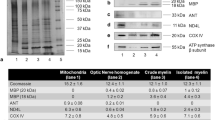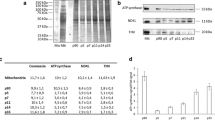Abstract
Recently, we have demonstrated that myelin conducts an extramitochondrial oxidative phosphorylation, hypothesizing a novel supportive role for myelin in favor of the axon. We have also hypothesized that the ATP produced in myelin could be transferred thought gap junctions. In this work, by biochemical, immunohistochemical, and electrophysiological techniques, the existence of a connection among myelin to the axon was evaluated, to understand how ATP could be transferred from sheath to the axoplasm. Data confirm a functional expression of oxidative phosphorylation in isolated myelin. Moreover, WB and immunohistochemistry on optic nerve slices show that connexins 32 and 43 are present in myelin and colocalize with myelin basic protein. Interestingly, addition of carbenoxolone or oleamide, two gap junction blockers, causes a decrease in oxidative metabolism in purified myelin, but not in mitochondria. Similar effects were observed on conduction speed in hippocampal Schaffer collateral, in the presence of oleamide. Confocal analysis of optic nerve slices showed that lucifer yellow (that only passes through aqueous pores) signal was found in both the sheath layers and the axoplasma. In the presence of oleamide, but not with oleic acid, signal significantly decreased in the sheath and was lost inside the axon. This suggests the existence of a link among myelin and axons. These results, while supporting the idea that ATP aerobically synthesized in myelin sheath could be transferred to the axoplasm through gap junctions, shed new light on the function of the sheath.








Similar content being viewed by others
Abbreviations
- ACSF:
-
Artificial cerebrospinal fluid
- ADP:
-
Adenosine diphosphate
- ANT:
-
Adenosine nucleotide translocase
- ATP:
-
Adenosine triphosphate
- EDTA:
-
Ethylenediaminetetraacetic acid
- EGTA:
-
Ethylene glycol tetraacetic acid
- HEPES:
-
4-(2-Hydroxyethyl)-1-piperazineethanesulfonic acid
- IM:
-
Isolated myelin
- MBP:
-
Myelin basic protein
- NADH:
-
Nicotinamide adenine dinucleotide reduced form
- OXPHOS:
-
Oxidative phosphorylation
- PBS:
-
Phosphate buffer saline
- PV:
-
Presynaptic volley
- R.O.D.:
-
Relative optical density
- SDS-PAGE:
-
Sodium dodecyl sulfate polyacrylamide gel electrophoresis
- TIM:
-
Transport inner membrane
- WB:
-
Western blot
References
Waxman SG (1977) Conduction in myelinated, unmyelinated, and demyelinated fibers. Arch Neurol 34:585–589
Morelli A, Ravera S, Panfoli I (2011) Hypothesis of an energetic function for myelin. Cell Biochem Biophys 61:179–187
Nave KA (2010) Myelination and the trophic support of long axons. Nat Rev Neurosci 11:275–283
Ravera S, Panfoli I, Calzia D et al (2009) Evidence for aerobic ATP synthesis in isolated myelin vesicles. Int J Biochem Cell Biol 41:1581–1591
Ravera S, Panfoli I, Aluigi MG et al (2011) Characterization of Myelin Sheath F(o)F(1)-ATP synthase and its regulation by IF(1). Cell Biochem Biophys 59:63–70
Ravera S, Bartolucci M, Calzia D et al (2013) Tricarboxylic acid cycle-sustained oxidative phosphorylation in isolated myelin vesicles. Biochimie 95:1991–1998
Ravera S, Nobbio L, Visigalli D et al (2013) Oxydative phosphorylation in sciatic nerve myelin and its impairment in a model of dysmyelinating peripheral neuropathy. J Neurochem 126:82–92. doi:10.1111/jnc.12253
Ravera S, Bartolucci M, Ramoino P, Calzia D, Traverso C, Panfoli I (2014) Oxydative Metabolism in Optic Nerve Myelin: New Perspectives in Hereditary Optic Neuropathies. Clin J Ophthalmol 1(1):003
Adriano E, Perasso L, Panfoli I et al (2011) A novel hypothesis about mechanisms affecting conduction velocity of central myelinated fibers. Neurochem Res 36:1732–1739
Goldberg GS, Moreno AP, Lampe PD (2002) Gap junctions between cells expressing connexin 43 or 32 show inverse permselectivity to adenosine and ATP. J Biol Chem 277:36725–36730
Guan X, Cravatt BF, Ehring GR et al (1997) The sleep-inducing lipid oleamide deconvolutes gap junction communication and calcium wave transmission in glial cells. J Cell Biol 139:1785–1792
Elgueta R, Tobar JA, Shoji KF et al (2009) Gap junctions at the dendritic cell-T cell interface are key elements for antigen-dependent T cell activation. J Immunol 183:277–284. doi:10.4049/jimmunol.0801854
Zhang C-L, Wilson JA, Williams J, Chiu SY (2006) Action potentials induce uniform calcium influx in mammalian myelinated optic nerves. J Neurophysiol 96:695–709. doi:10.1152/jn.00083.2006
Rash JE (2010) Molecular disruptions of the panglial syncytium block potassium siphoning and axonal saltatory conduction: pertinence to neuromyelitis optica and other demyelinating diseases of the central nervous system. Neuroscience 168:982–1008. doi:10.1016/j.neuroscience.2009.10.028
Singer M, Salpeter MM (1966) The transport of 3H-l-histidine through the Schwann and myelin sheath into the axon, including a reevaluation of myelin function. J Morphol 120:281–315. doi:10.1002/jmor.1051200305
Bruni A, Luciani S, Contessa AR, Azzone GF (1964) Effects of atractyloside and oligomycin on energy-transfer reactions. Biochim Biophys Acta 82:630–632
Vega C, Martiel JL, Drouhault D et al (2003) Uptake of locally applied deoxyglucose, glucose and lactate by axons and Schwann cells of rat vagus nerve. J Physiol 546:551–564
Endong L, Shijie J, Sonobe Y et al (2011) The gap-junction inhibitor carbenoxolone suppresses the differentiation of Th17 cells through inhibition of IL-23 expression in antigen presenting cells. J Neuroimmunol 240–241:58–64. doi:10.1016/j.jneuroim.2011.09.012
Herrero-Gonzalez S, Valle-Casuso JC, Sanchez-Alvarez R et al (2009) Connexin43 is involved in the effect of endothelin-1 on astrocyte proliferation and glucose uptake. Glia 57:222–233
Norton WT, Poduslo SE (1973) Myelination in rat brain: method of myelin isolation. J Neurochem 21:749–757
Ravera S, Calzia D, Panfoli I et al (2007) Simultaneous detection of molecular weight and activity of adenylate kinases after electrophoretic separation. Electrophoresis 28:291–300
Laemmli UK (1970) Cleavage of structural proteins during the assembly of the head of bacteriophage T4. Nature 227:680–685
Ravera S, Bartolucci M, Barbarito G et al (2013) Electrophoretic separation of purified myelin: a method to improve the protein pattern resolving. Prep Biochem Biotechnol 43:342–349. doi:10.1080/10826068.2012.737398
Bradford MM (1976) A rapid and sensitive method for the quantitation of microgram quantities of protein utilizing the principle of protein-dye binding. Anal Biochem 72:248–254
Heyman NS, Burt JM (2008) Hindered diffusion through an aqueous pore describes invariant dye selectivity of Cx43 junctions. Biophys J 94:840–854. doi:10.1529/biophysj.107.115634
Perasso L, Lunardi GL, Risso F et al (2008) Protective effects of some creatine derivatives in brain tissue anoxia. Neurochem Res 33:765–775
Rebaudo R, Melani R, Carita F et al (2000) Increase of cerebral phosphocreatine in normal rats after intracerebroventricular administration of creatine. Neurochem Res 25:1493–1495
Balestrino M, Aitken PG, Somjen GG (1986) The effects of moderate changes of extracellular K+ and Ca2+ on synaptic and neural function in the CA1 region of the hippocampal slice. Brain Res 377:229–239
Meier S, Brauer AU, Heimrich B et al (2004) Myelination in the hippocampus during development and following lesion. Cell Mol Life Sci 61:1082–1094
Lemasters JJ, Sowers AE (1979) Phosphate dependence and atractyloside inhibition of mitochondrial oxidative phosphorylation. The ADP-ATP carrier is rate-limiting. J Biol Chem 254:1248–1251
Nagy JI, Ionescu AV, Lynn BD, Rash JE (2003) Connexin29 and connexin32 at oligodendrocyte and astrocyte gap junctions and in myelin of the mouse central nervous system. J Comp Neurol 464:356–370.
Perasso L, Adriano E, Ruggeri P et al (2009) In vivo neuroprotection by a creatine-derived compound: phosphocreatine-Mg-complex acetate. Brain Res 1285:158–163
Perasso L, Spallarossa P, Gandolfo C et al (2011) Therapeutic use of creatine in brain or heart ischemia: available data and future perspectives. Med Res Rev 33:336–363
Zapara TA, Simonova OG, Zharkikh AA et al (2004) Seasonal differences and protection by creatine or arginine pretreatment in ischemia of mammalian and molluscan neurons in vitro. Brain Res 1015:41–49
Balestrino M, Rebaudo R, Lunardi G (1999) Exogenous creatine delays anoxic depolarization and protects from hypoxic damage: dose-effect relationship. Brain Res 816:124–130
Whittingham TS, Lipton P (1981) Cerebral synaptic transmission during anoxia is protected by creatine. J Neurochem 37:1618–1621
Kass IS, Lipton P (1982) Mechanisms involved in irreversible anoxic damage to the in vitro rat hippocampal slice. J Physiol 332:459–472
Harris JJ, Attwell D (2013) Is myelin a mitochondrion? J Cereb Blood Flow Metab 33:33–36
Morelli AM, Ravera S, Calzia D, Panfoli I (2013) Hypothesis of lipid-phase-continuity proton transfer for aerobic ATP synthesis. J Cereb Blood Flow Metab 33:1838–1842
Cherepanov DA, Junge W, Mulkidjanian AY (2004) Proton transfer dynamics at the membrane/water interface: dependence on the fixed and mobile pH buffers, on the size and form of membrane particles, and on the interfacial potential barrier. Biophys J 86:665–680
Mulkidjanian AY (2006) Proton in the well and through the desolvation barrier. Biochim Biophys Acta 1757:415–427
Kell DB (1979) On the functional proton current pathway of electron transport phosphorylation. An electrodic view. Biochim Biophys Acta 549:55–99
Nave KA, Trapp BD (2008) Axon-glial signaling and the glial support of axon function. Annu Rev Neurosci 31:535–561
Margineanu DG, Klitgaard H (2001) Can gap-junction blockade preferentially inhibit neuronal hypersynchrony vs. excitability? Neuropharmacology 41:377–383
Schenone A, Nobbio L, Monti Bragadin M et al (2011) Inherited neuropathies. Curr Treat Options Neurol 13:160–179
Parenti R, Cicirata F, Zappalà A et al (2010) Dynamic expression of Cx47 in mouse brain development and in the cuprizone model of myelin plasticity. Glia 58:1594–1609. doi:10.1002/glia.21032
Lee Y, Morrison BM, Li Y et al (2012) Oligodendroglia metabolically support axons and contribute to neurodegeneration. Nature 487:443–448
Funfschilling U, Supplie LM, Mahad D et al (2012) Glycolytic oligodendrocytes maintain myelin and long-term axonal integrity. Nature 485:517–521
Hall CN, Klein-Flugge MC, Howarth C, Attwell D (2012) Oxidative phosphorylation, not glycolysis, powers presynaptic and postsynaptic mechanisms underlying brain information processing. J Neurosci 32:8940–8951
Veltri KL, Espiritu M, Singh G (1990) Distinct genomic copy number in mitochondria of different mammalian organs. J Cell Physiol 143:160–164
Erecinska M, Silver IA (1989) ATP and brain function. J Cereb Blood Flow Metab 9:2–19
Kann O, Kovacs R (2007) Mitochondria and neuronal activity. Am J Physiol Cell Physiol 292:C641–C657
Acknowledgments
This study was supported by a Grant from the “Compagnia di San Paolo”-Neuroscience Program 2008, for the research project entitled: “Energetic metabolism in myelinated axon: a new trophic role of myelin sheath,” and from the “Fondazione Giuseppe Levi–Accademia Nazionale dei Lincei” for the research project entitled: “Produzione extramitocondriale di ATP in mielina: localizzazione dei complessi della catena respiratoria e possible ruolo nella degenerazione assonale in Sclerosi Multipla.”
Author information
Authors and Affiliations
Corresponding author
Rights and permissions
About this article
Cite this article
Ravera, S., Bartolucci, M., Adriano, E. et al. Support of Nerve Conduction by Respiring Myelin Sheath: Role of Connexons. Mol Neurobiol 53, 2468–2479 (2016). https://doi.org/10.1007/s12035-015-9216-0
Received:
Accepted:
Published:
Issue Date:
DOI: https://doi.org/10.1007/s12035-015-9216-0




